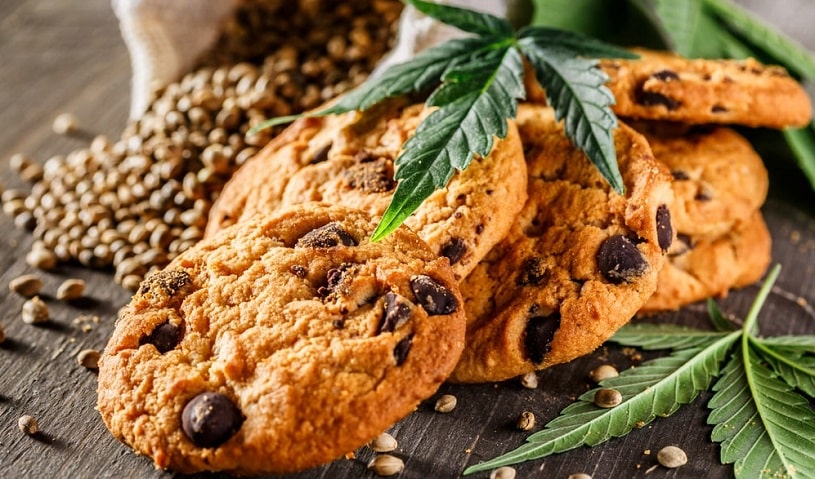Consumption of various food infused with active compounds of cannabis (popularly known as marijuana edibles) is an alternative to vaporizing or smoking weed. Different products are infused with varying amounts of tetrahydrocannabinol (THC) to produce potent weed gummies, weed cookies, cannabis butter, or even drinks. Ideally, the amount of THC delivered by these treats should be indicated as part of the products’ packaging process. However, one can never be too sure that the indicated levels are accurate.
Table Of Contents:
Cannabis Edibles Explained
Marijuana edibles are food items infused with active cannabinoids CBD, THC, or both, packaged just like other foods and drinks on the market. The active compounds should be in carefully portioned amounts resulting in a tasty treat that can be consumed orally. This should not be taken to mean that they are completely safe. Some manufacturers may not be as attentive to the dosage of the active compounds, which can result in overdose and adverse reactions.
Note that marijuana in whatever form is still illegal in some states.
Most of the pot edibles sold in legal marijuana dispensaries are lab-tested for dosage and potency. As part of the packaging process, the infused edibles are clearly labeled to easily identify active cannabinoids and their quantities.
Examples Of Edible Marijuana Food Items Are:
- Candy bars
- Chewy candies
- Cookies
- Beef jerky
- Gummy candies
- Brownies
- Butter
Depending on the targeted effect, such as relaxation, sedation, or stimulation, pot edibles can be made from different cannabis strains, including hybrids.
Health Benefits of Weed Edibles
Besides recreational use, cannabis-infused foods can have a medical effect as a remedy for pain, anxiety, poor appetite, muscle spasms, insomnia, depression, et cetera.
Difference Between Eating Marijuana And Smoking Pot
Although the net effect of ingesting weed-infused products and smoking a blunt is the same, there are notable differences in the way the body responds to the two modes of cannabis use.
After smoking cannabis, THC – the active compound responsible for its psychological effects – is absorbed into the bloodstream through the alveoli. With this route of administration, the effects of THC will be achieved faster. On the downside, the user will be predisposed to lung damage owing to the inhalation of other elements contained within this smoke.

Once weed-infused foods are consumed, the liver breaks down THC to various metabolites, whose psychogenic effects won’t be realized until at least 30 minutes later when the liver starts releasing them into the bloodstream. The psychological effects of orally consumed weed will last longer due to the sustained release of psychoactive metabolites from the liver. The active compound released after the metabolism of active THC in the liver can better penetrate the brain than unmetabolized THC. This makes for a more pronounced high that lasts for longer durations of time. It should also be noted that the amount of THC in homemade marijuana edibles is in most cases unknown. For this reason, the risk of accidental overdose goes up substantially.
When considering the dangers of edible marijuana vis-à-vis smoking, two perspectives must be adopted. The first is the danger to the people around. Smoking oftentimes sparks complaints from neighbors because of the smell and the secondhand smoke that results. Edible marijuana, on the other hand, gives a more discreet way to take in cannabis without anyone around feeling offended. The second safety aspect is the effect of pot on the body bearing in mind that it has been used for medical purposes for a very long time.
| Smoking a blunt | Consuming marijuana edibles | |
|---|---|---|
| Onset of action | Seconds to minutes | 30 minutes – 2 hours |
| Peak action time | Around 30 minutes | Around 4 hours |
| Duration of action | Around 6 hours | Around 12 hours |
| Lung damage | profound | None |
| Danger to people around | Likely to irritate others around the user due to passive smoking. | Effects are solely experienced by the consumer. |
Negative Effects of Pot Edibles
Even though a majority of users have given this form of marijuana a clean bill of health, it should be understood that this is a relatively new thing that has not been fully understood. Therefore, consuming such products can also cause side effects, as well as smoking cannabis.
Dry Mouth
Salivary glands have been shown to contain receptors for cannabinoids, which are contained in cannabis. Once active compounds are absorbed into the bloodstream, they affect all systems that express cannabinoid receptors. Salivary glands fall in this category. The effect is downregulation of saliva production, leading to a dry mouth, commonly referred to as ‘cotton mount’ or xerostomia.
Altered Brain Function
Marijuana brownies and other edibles can alter the functioning of the brain. Although the THC content should be indicated, one can never be too sure of the amount infused in these edibles. The common side effects of this alteration are hyperventilation and frightening hallucinations. Since edibles last longer in the system, the effects of marijuana on the teenage brain and adult users are profound.
Paranoia and Anxiety
It’s not a guarantee that when people eat marijuana gummies or cookies, they will end up feeling high. They may get low or even anxious. Even those without a history of paranoia or anxiety are not immune to the side effect of edibles.

Accidental Overdose on Weed Edibles
Accidental overdose can either occur in children who stumble upon weed edibles or first-time adult users. In the former, children may come across these weed cookies, gummies, cannabis butter, or other forms of edible marijuana and consume them unknowingly. Since the use of cannabis in children has not been studied extensively, unexpected effects might result. In the latter, adults who are using cannabis edibles will be impatient since it takes a while to realize the psychogenic effects. Therefore, they will try to consume more, leading to an overdose half an hour later when the liver pours the potent THC metabolites into the bloodstream.
Edible Weed Statistics
Cannabis edibles are becoming a huge niche for entrepreneurs. In California, sales of marijuana-infused drinks and foods totaled $180 million in 2017. In Washington State, pot-infused products such as weed gummies recorded an increase of 121% in sales over the same period.
In a Marijuana Baseline Health Study done by the Massachusetts Department of Public Health (DPH), 6,934 respondents were surveyed. The number that reported using either marijuana or marijuana products for medical purposes in the previous 12 months was 65%. Approximately 20% reported having used cannabis products for medical purposes in the previous three years.
Avoiding the Risks Of Weed Edibles
In a nutshell, The use of weed edibles carries a significant amount of risk. If you harbor intentions of experimenting with this emerging trend, caution should be exercised. Furthermore, there may be long term effects on health that science is yet to unearth. More research is needed to understand their short term and long term effects fully.
Several options exist for the user who desires to quit cannabis use. Few lucky users have been able to make a decision and stop marijuana use without the need for inpatient rehabilitation centers. Rates of relapse are relatively high for those who choose this route. As such, inpatient rehabilitation programs provide a safer and more effective way of beating pot addiction.
Page Sources
- Monica Bharel. Marijuana Baseline Health Study Report of Findings. 2018.https://www.mass.gov/files/documents/2018/06/29/DPH%20Legislative%20Report%20-%20Marijuana%20Baseline%20Health%20Study.pdf
- National Center for Chronic Disease Prevention and Health Promotion (NCCDPHP). Marijuana and Public Health. 2018. Marijuana and Public Health https://www.cdc.gov/marijuana/faqs/edibles.html
- Daniel G. Barrus. Tasty THC: Promises and Challenges of Cannabis Edibles. 2017. https://www.ncbi.nlm.nih.gov/pmc/articles/PMC5260817/
- Robert F.X. Klein. Analysis of “Marijuana Edibles” – Food Products Containing Marijuana or Marijuana Extracts – An Overview. Review, and Literature Survey. 2016. https://admin.dea.gov/sites/default/files/pr/microgram-journals/2017/mj14-1_9-32.pdf
- Mike Montgomery. Edibles Are The Next Big Thing For Pot Entrepreneurs. 2017. https://www.forbes.com/sites/mikemontgomery/2017/07/19/edibles-are-the-next-big-thing-for-pot-entrepreneurs/
- Alaska Department of Health and Social Services. Marijuana Edibles Safety. http://dhss.alaska.gov/dph/Director/Pages/marijuana/edibles.aspx
- Bettina Friese. Teen Use of Marijuana Edibles: A Focus Group Study of an Emerging Issue. 2016. https://pubmed.ncbi.nlm.nih.gov/27056685/

 Authored by
Authored by  Reviewed by
Reviewed by 
